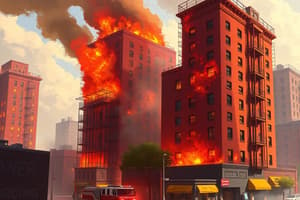Podcast
Questions and Answers
What is a foundational factor for effective fire operations in mid-rise fires?
What is a foundational factor for effective fire operations in mid-rise fires?
- Effective evaluation of incident conditions and fast fire location (correct)
- Reassessing resources only after initial attack starts
- Avoiding sectorization to minimize complexity
- Delaying the evaluation of incident conditions
How does effective sectorization contribute to fireground operations?
How does effective sectorization contribute to fireground operations?
- Improves span of control and command safety (correct)
- Increases the number of firefighters on scene
- Decreases supervision needed for critical tasks
- Reduces the importance of exterior access points
When is exterior aerial apparatus particularly necessary during mid-rise fire operations?
When is exterior aerial apparatus particularly necessary during mid-rise fire operations?
- For all initial fire attacks regardless of conditions
- When interior conditions prevent safe operations or delay in attack (correct)
- Exclusively for isolation of victims who cannot be rescued
- Only when interior access is available and safe
What aspect should be prioritized to execute potential exterior rescues in a fire scenario?
What aspect should be prioritized to execute potential exterior rescues in a fire scenario?
What role does water supply play if an interior attack is delayed in a mid-rise fire?
What role does water supply play if an interior attack is delayed in a mid-rise fire?
Which action is critical when coordinating with interior fire attack teams?
Which action is critical when coordinating with interior fire attack teams?
What must be monitored to ensure safe evacuation stairwell access?
What must be monitored to ensure safe evacuation stairwell access?
In the event of a cold smoke situation, what should be recognized?
In the event of a cold smoke situation, what should be recognized?
What does the rescue profile primarily determine in fire scenarios?
What does the rescue profile primarily determine in fire scenarios?
Which factor is not associated with monitoring the fire attack stairwell?
Which factor is not associated with monitoring the fire attack stairwell?
What is a key consideration when conducting a large area, targeted search?
What is a key consideration when conducting a large area, targeted search?
Which task is least likely to be considered a secondary tactical position during fire rescue operations?
Which task is least likely to be considered a secondary tactical position during fire rescue operations?
What challenge arises from occupants potentially not sheltering in place?
What challenge arises from occupants potentially not sheltering in place?
What is the primary benefit of locating the fire as early as possible during mid-rise fire operations?
What is the primary benefit of locating the fire as early as possible during mid-rise fire operations?
Why is a pessimistic evaluation of required resources critical in managing fire attacks in mid-rise fires?
Why is a pessimistic evaluation of required resources critical in managing fire attacks in mid-rise fires?
What role does effective sectorization play in mid-rise fire operations?
What role does effective sectorization play in mid-rise fire operations?
What is a critical consideration regarding apparatus placement during mid-rise fire operations?
What is a critical consideration regarding apparatus placement during mid-rise fire operations?
Why is appropriate hose and nozzle selection critical during mid-rise fires?
Why is appropriate hose and nozzle selection critical during mid-rise fires?
What is a critical factor to determine during a fire attack on the fire floor?
What is a critical factor to determine during a fire attack on the fire floor?
Which consideration is essential when monitoring the conditions of floors above the fire?
Which consideration is essential when monitoring the conditions of floors above the fire?
What is an important task for the coordination of secondary needs during rescue operations?
What is an important task for the coordination of secondary needs during rescue operations?
How should the rescue profile be adjusted during firefighting operations?
How should the rescue profile be adjusted during firefighting operations?
What is a significant concern when coordinating an evacuation from multiple floors?
What is a significant concern when coordinating an evacuation from multiple floors?
What human factor complicates the evacuation process during a fire incident?
What human factor complicates the evacuation process during a fire incident?
What should be monitored to ensure effective water supply during a fire attack?
What should be monitored to ensure effective water supply during a fire attack?
What factor is critical to recognize during cold smoke situations?
What factor is critical to recognize during cold smoke situations?
What effect does effective sectorization have on the safety of firefighters?
What effect does effective sectorization have on the safety of firefighters?
Why is the placement of aerial apparatus considered a critical decision in mid-rise fire operations?
Why is the placement of aerial apparatus considered a critical decision in mid-rise fire operations?
What is a consequence of a delayed interior attack during mid-rise fire operations?
What is a consequence of a delayed interior attack during mid-rise fire operations?
What consideration is critical for fireground operations when assessing water supply?
What consideration is critical for fireground operations when assessing water supply?
What happens if initial observations inaccurately assess the required resources for a mid-rise fire?
What happens if initial observations inaccurately assess the required resources for a mid-rise fire?
What is critical to establish and monitor on the fire floor to ensure effective air management?
What is critical to establish and monitor on the fire floor to ensure effective air management?
Which of the following is NOT an aspect to consider when determining structural involvement during a fire attack?
Which of the following is NOT an aspect to consider when determining structural involvement during a fire attack?
During fire floor operations, what should be coordinated with secondary needs for treatment and transportation?
During fire floor operations, what should be coordinated with secondary needs for treatment and transportation?
What potential condition must be recognized when determining the impacts of smoke during a fire?
What potential condition must be recognized when determining the impacts of smoke during a fire?
Which human factor must be addressed when evaluating rescue profiles and best actions during a firefighting operation?
Which human factor must be addressed when evaluating rescue profiles and best actions during a firefighting operation?
When conducting a large area, targeted search after fire control has been achieved, which aspect is crucial?
When conducting a large area, targeted search after fire control has been achieved, which aspect is crucial?
Which option best describes a crucial task when rescuing individuals from the floors above during a fire incident?
Which option best describes a crucial task when rescuing individuals from the floors above during a fire incident?
What key element should be recognized when monitoring for cold smoke situations?
What key element should be recognized when monitoring for cold smoke situations?
Flashcards are hidden until you start studying
Study Notes
Strategic Level Considerations in Mid-Rise Fires
- Effective initial decision-making and actions heavily influence outcomes in mid-rise fire scenarios.
- Rapid evaluation of incident conditions and quick location of the fire are foundational to operation success.
- A realistic assessment of resources is essential for managing fire attacks and victim rescues on multiple floors.
- Early identification of critical tactical positions enhances efficiency in operations.
- Effective sectorization improves control, supervision, and firefighter safety during operations.
- Clear sector assignments lead to better work outcomes and increased firefighter safety.
Apparatus Placement and Access
- Exterior rescue execution depends on prioritizing apparatus placement for quick access.
- Accessibility for aerial ladders and platforms is critical for simultaneous rescues and fire attack.
- Exterior aerial apparatus should also facilitate standpipe operations if interior attacks are delayed or unsafe.
Critical Tactical Positions
-
Exterior Rescue:
- Identify the location and removal means for victims.
- Assess required resources for rescues.
- Coordinate rescues with interior teams and additional treatment needs.
-
Fire Floor(s):
- Monitor fire attack and evacuation stairwells based on conditions.
- Assess fire occupancy, structural involvement, and potential for attic involvement.
- Evaluate wind-driven fire conditions and exposures on the fire floor.
- Manage cold smoke situations where sprinklers may have extinguished the fire prior to arrival.
- Plan for stack effect conditions that affect egress and life safety.
- Establish protocols for effective water supply and ventilation measures.
-
Floors Above:
- Assess conditions for continued rescues and fire extension.
- Monitor the structural integrity and fire conditions affecting upper floors.
- Continue effective water supplies and establish safe refuges for responders.
- Conduct large area searches post-fire control with sufficient time allocated but not in immediate danger.
Human Factors and Safety
- Occupants may not shelter in place and often exit via familiar routes, creating additional risks.
- Clear identification of attack and evacuation routes is vital for every floor.
Secondary Tactical Positions
- Essential support positions include triage, extrication, treatment, and transportation.
- Ventilation and building system evaluations are crucial for effective emergency response.
- Prioritize occupant services to manage additional needs during fire incidents.
Strategic Level Considerations in Mid-Rise Fires
- Effective initial decision-making and actions heavily influence outcomes in mid-rise fire scenarios.
- Rapid evaluation of incident conditions and quick location of the fire are foundational to operation success.
- A realistic assessment of resources is essential for managing fire attacks and victim rescues on multiple floors.
- Early identification of critical tactical positions enhances efficiency in operations.
- Effective sectorization improves control, supervision, and firefighter safety during operations.
- Clear sector assignments lead to better work outcomes and increased firefighter safety.
Apparatus Placement and Access
- Exterior rescue execution depends on prioritizing apparatus placement for quick access.
- Accessibility for aerial ladders and platforms is critical for simultaneous rescues and fire attack.
- Exterior aerial apparatus should also facilitate standpipe operations if interior attacks are delayed or unsafe.
Critical Tactical Positions
-
Exterior Rescue:
- Identify the location and removal means for victims.
- Assess required resources for rescues.
- Coordinate rescues with interior teams and additional treatment needs.
-
Fire Floor(s):
- Monitor fire attack and evacuation stairwells based on conditions.
- Assess fire occupancy, structural involvement, and potential for attic involvement.
- Evaluate wind-driven fire conditions and exposures on the fire floor.
- Manage cold smoke situations where sprinklers may have extinguished the fire prior to arrival.
- Plan for stack effect conditions that affect egress and life safety.
- Establish protocols for effective water supply and ventilation measures.
-
Floors Above:
- Assess conditions for continued rescues and fire extension.
- Monitor the structural integrity and fire conditions affecting upper floors.
- Continue effective water supplies and establish safe refuges for responders.
- Conduct large area searches post-fire control with sufficient time allocated but not in immediate danger.
Human Factors and Safety
- Occupants may not shelter in place and often exit via familiar routes, creating additional risks.
- Clear identification of attack and evacuation routes is vital for every floor.
Secondary Tactical Positions
- Essential support positions include triage, extrication, treatment, and transportation.
- Ventilation and building system evaluations are crucial for effective emergency response.
- Prioritize occupant services to manage additional needs during fire incidents.
Strategic Level Considerations in Mid-Rise Fires
- Effective initial decision-making and actions heavily influence outcomes in mid-rise fire scenarios.
- Rapid evaluation of incident conditions and quick location of the fire are foundational to operation success.
- A realistic assessment of resources is essential for managing fire attacks and victim rescues on multiple floors.
- Early identification of critical tactical positions enhances efficiency in operations.
- Effective sectorization improves control, supervision, and firefighter safety during operations.
- Clear sector assignments lead to better work outcomes and increased firefighter safety.
Apparatus Placement and Access
- Exterior rescue execution depends on prioritizing apparatus placement for quick access.
- Accessibility for aerial ladders and platforms is critical for simultaneous rescues and fire attack.
- Exterior aerial apparatus should also facilitate standpipe operations if interior attacks are delayed or unsafe.
Critical Tactical Positions
-
Exterior Rescue:
- Identify the location and removal means for victims.
- Assess required resources for rescues.
- Coordinate rescues with interior teams and additional treatment needs.
-
Fire Floor(s):
- Monitor fire attack and evacuation stairwells based on conditions.
- Assess fire occupancy, structural involvement, and potential for attic involvement.
- Evaluate wind-driven fire conditions and exposures on the fire floor.
- Manage cold smoke situations where sprinklers may have extinguished the fire prior to arrival.
- Plan for stack effect conditions that affect egress and life safety.
- Establish protocols for effective water supply and ventilation measures.
-
Floors Above:
- Assess conditions for continued rescues and fire extension.
- Monitor the structural integrity and fire conditions affecting upper floors.
- Continue effective water supplies and establish safe refuges for responders.
- Conduct large area searches post-fire control with sufficient time allocated but not in immediate danger.
Human Factors and Safety
- Occupants may not shelter in place and often exit via familiar routes, creating additional risks.
- Clear identification of attack and evacuation routes is vital for every floor.
Secondary Tactical Positions
- Essential support positions include triage, extrication, treatment, and transportation.
- Ventilation and building system evaluations are crucial for effective emergency response.
- Prioritize occupant services to manage additional needs during fire incidents.
Studying That Suits You
Use AI to generate personalized quizzes and flashcards to suit your learning preferences.




